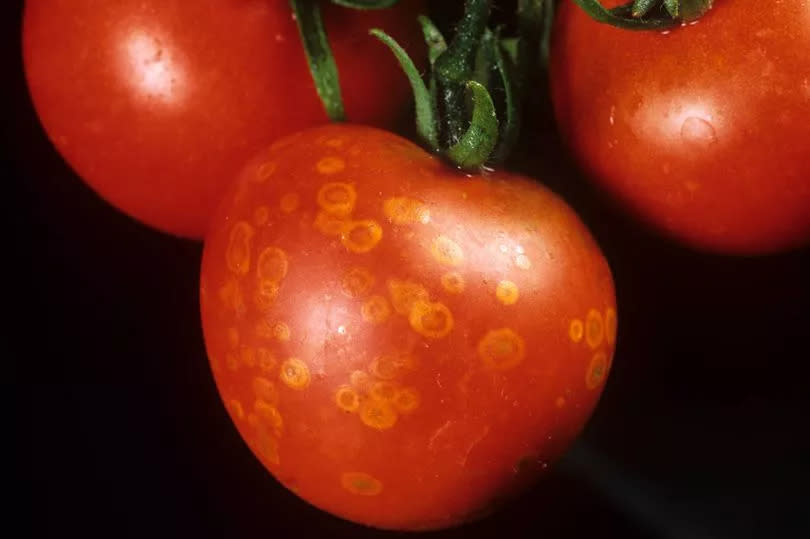Brown spots and diseased leaves can mean pests and diseases. This time of year, tomatoes often experience problems, whether it’s browning leaves or distorted and damaged fruit.
So what went wrong? Dr Anton Rosenfeld, research director at gardening charity Garden Organic, says tomato problems are common in August and September: “Of course, tomatoes grown outdoors will be more at risk of disease and the plants tend to become a bit weaker towards the end of summer.”
Common tomato problems and what to do about them
Rottenness
If you’re growing tomatoes outside, this is one of the most common diseases, says Dr. Rosenfeld, and is encouraged by wet, hot, and stagnant conditions. “You’ll see brown, penny-sized lesions on the leaf margins that are pretty noticeable. If you only see one or two on the leaves, you can try to pull them off, but once it gets to about 10% of the leaves, you’re fighting a losing battle.”
If the blight, a wind-borne fungus that also affects potato plants, spreads to the stems, turning them black and spreading rapidly, it is likely too late as it can destroy the plant within a few days, he adds. Affected tomatoes will turn brown and become inedible and will need to be disposed of. You can try cutting off the stems and blackened stalks of affected tomatoes to stop the attack, but it is usually too late to save the plant.
“It’s weather dependent, so if it’s very sunny and there’s very little infection, it may dry out and not spread, but if there are humid conditions, it will spread,” he warns.
If you have an infected plant, harvest and monitor the tomatoes before they become infected, he advises. They will ripen but are more likely to rot quickly. “When they’re grown in a greenhouse, it’s not as much of a problem because it’s the rain that falls on the leaves and spreads the spores.”
Creating better airflow for your plants can help prevent this, as the tangled leaf mass only promotes moisture and increases the chances of spores germinating when they land on the plant. So remove some of the lower leaves and excess side shoots to give the plant better ventilation and produce higher-quality fruit, he suggests.
Blossom end rot
The telltale sign of brown sunken circles at the base of the fruit, making them inedible, is caused by a lack of calcium reaching the tips of the fruit due to lack of water, he explains. Infrequent watering or simply not enough watering leads to blossom end rot.
If you don’t water enough, you may also see the fruit crack, he adds. “When you dry out a pot and then add lots of water, the fruit grows so fast that it starts to crack.”
Water your tomato plants regularly to prevent blossom-end rot and cracking, she advises. You won’t heal cracked fruit, but if you water regularly, the resulting fruit won’t suffer the same disaster.

Red spider mite
These tiny mites create pinholes in the plant that can cause the leaves to die. In severe cases, you can see spiderweb-like debris on the plants. “This tends to be more of a problem in greenhouses when conditions inside are really dry,” Dr. Rosenfeld says, “and if you have cucumbers and eggplants in your greenhouse, it’s usually much worse. Then it will spread to tomatoes.”
Fortunately, spider mites don’t affect the fruits too much, they just make the rest of the plant look sick. To prevent this, increase the humidity in the greenhouse by misting them with water.
Alternatively, you can use a biological control, a predatory mite that attacks the red spider mite, but you need to use it before it becomes a real problem, he advises. The biological control can be ordered by mail and then hung in the greenhouse where it releases the predatory mites. “Again, this is a problem that gets worse in August and September.”
Nutritional Deficiency
“Tomato plants sometimes get magnesium deficient, which causes lots of brown spots on the leaves. You can feed tomato plants or spray them with Epsom salt solution, which seems to revitalize them,” he says.
If you don’t feed tomato plants enough, they will become depleted of nitrogen and potassium. Feed them with comfrey or nettle feed to improve their nutrient content. Feed the plants once a week, he recommends.
Ghost Point
If your tomatoes have pale green or yellow spots or rings, the plant may be falling victim to ghost spot, or the gray mold fungus Botrytis cinerea. Spores from this fungus are spread by rain or splashing water and through the air. However, it is not as serious as some other diseases because you can still eat the spotted fruit and the fungus may not spread to all the fruit on the bunch. If you are growing tomatoes indoors, reduce the potential spread by removing plant debris that could harbor spores and increasing ventilation.